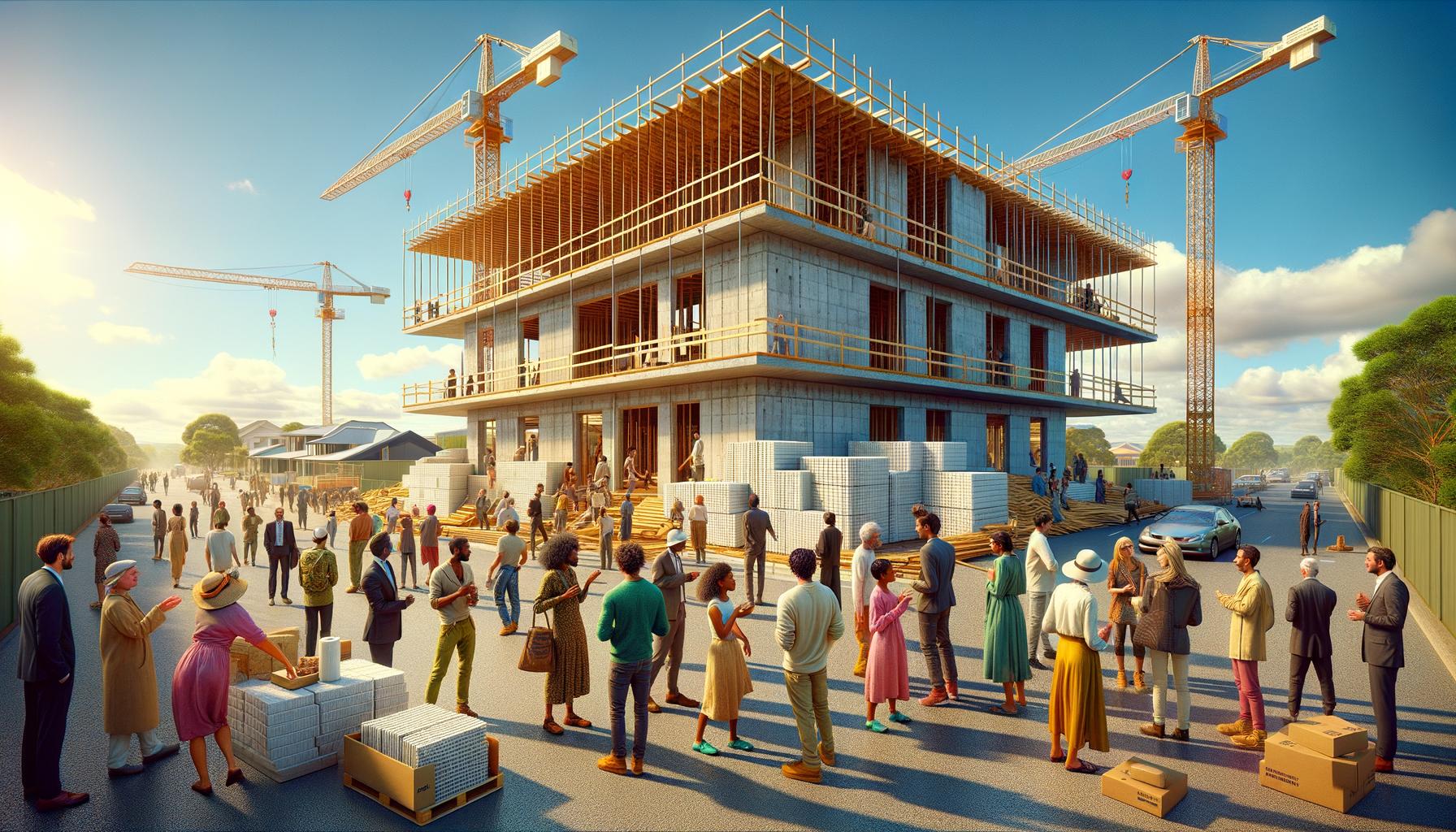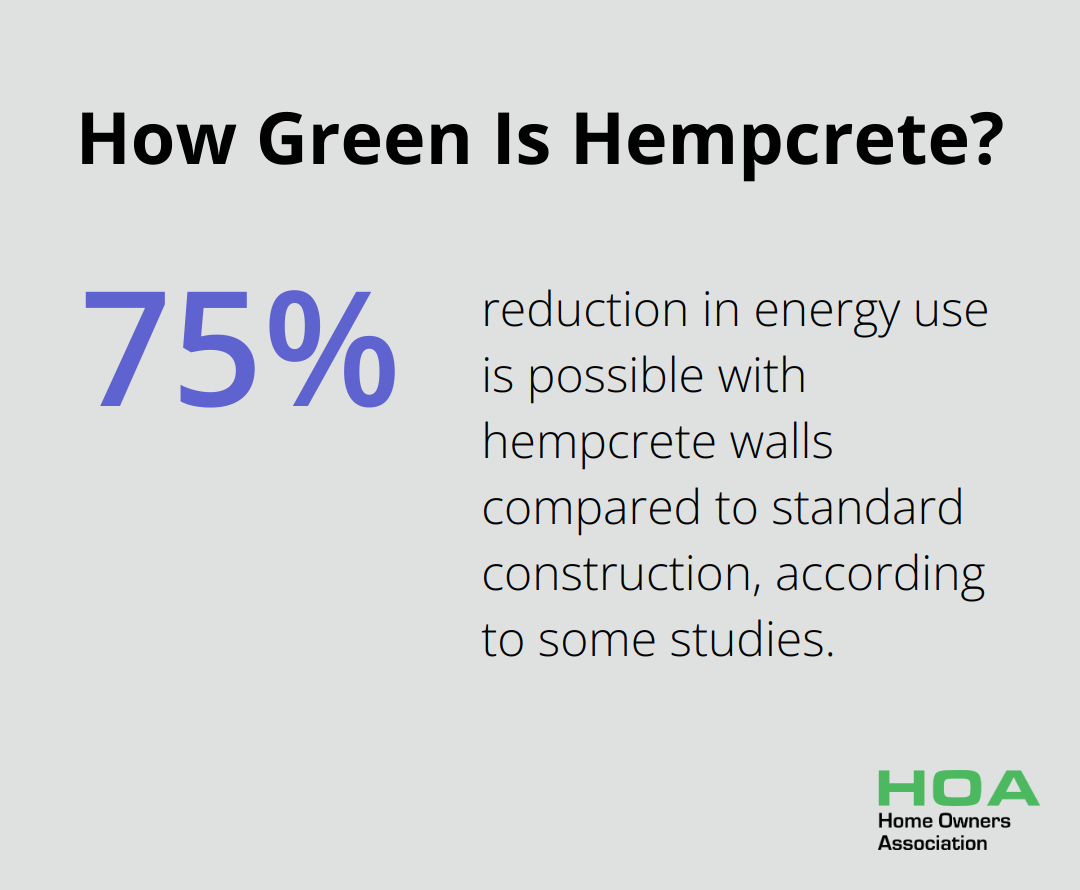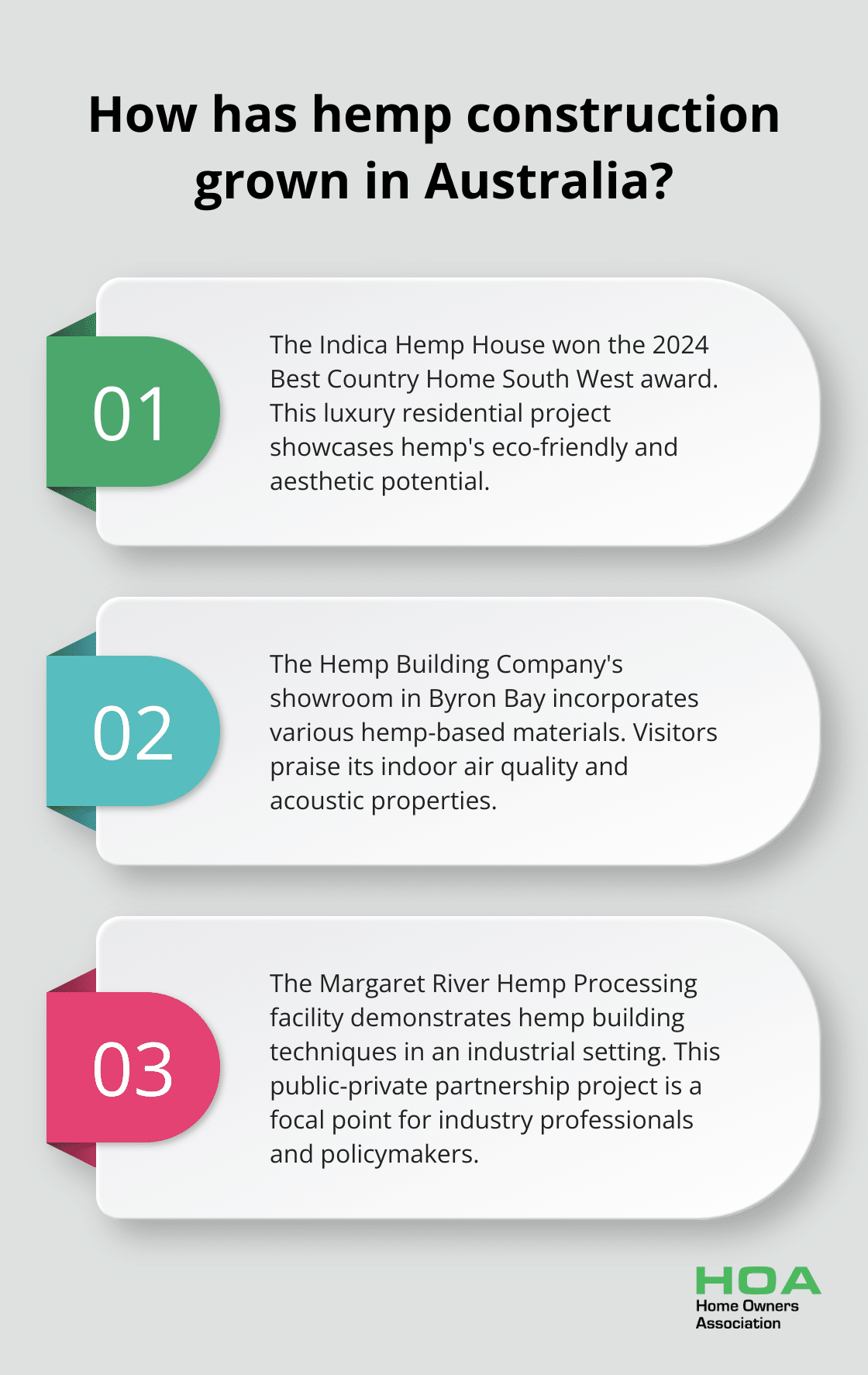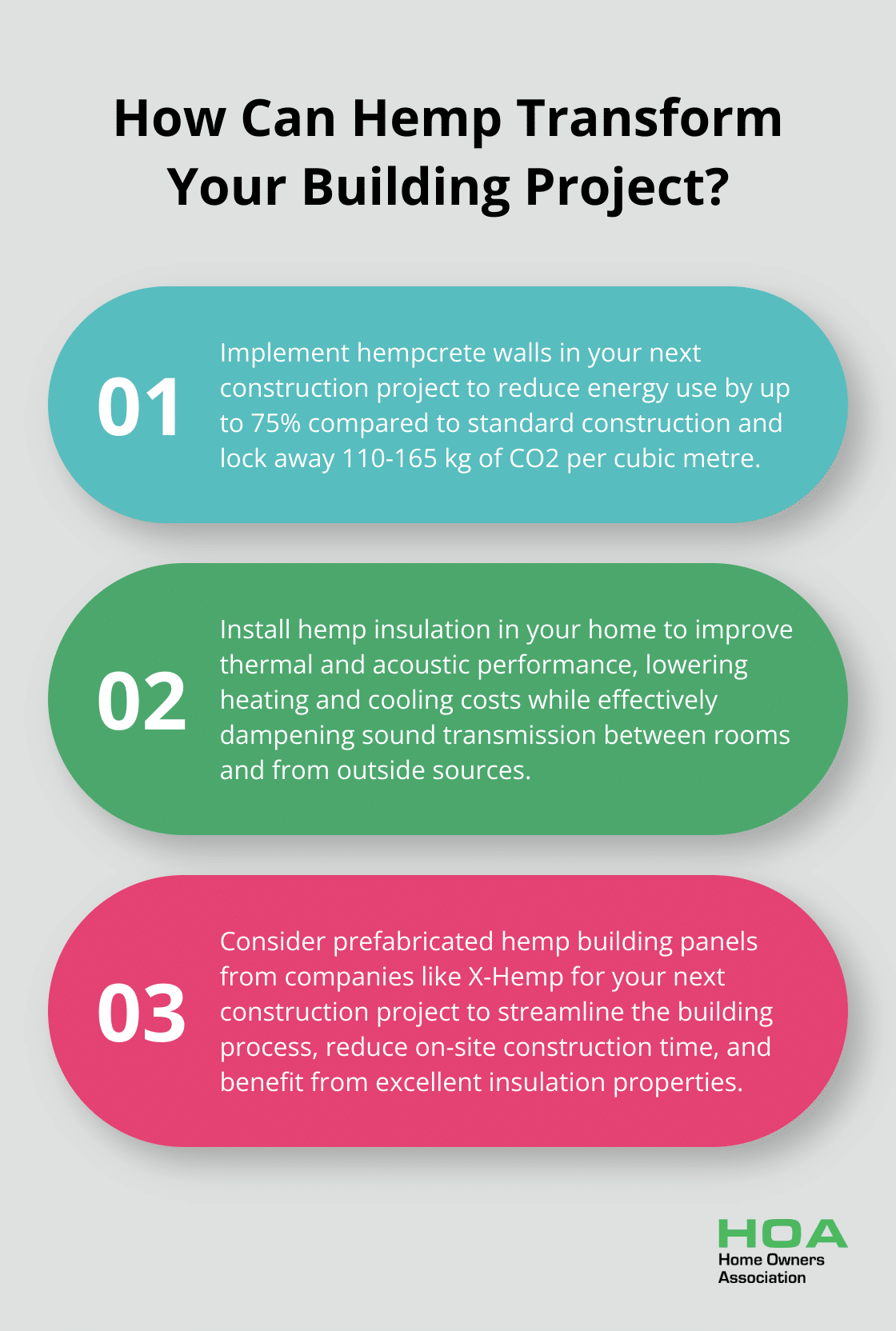
At Home Owners Association, we’re excited to explore the growing trend of hemp building materials in Australia. This innovative approach to construction is revolutionizing the industry with its eco-friendly properties and versatile applications.
Hemp-based materials are gaining traction in Australian sustainable building practices, offering a range of benefits from improved insulation to reduced carbon footprint. As we delve into this green construction movement, we’ll examine the properties, applications, and real-world examples of hemp building materials in Australia.
Why Hemp Is Revolutionizing Australian Construction
The Green Revolution in Building
Australia’s construction industry is experiencing a significant shift towards sustainable practices, with hemp-based materials leading the charge. This movement towards eco-friendly building solutions addresses urgent environmental concerns and meets the increasing demand for sustainable living spaces.
Hemp’s Environmental Advantages
Hemp building materials have captured the attention of the construction sector due to their remarkable environmental benefits. Recent research explores the vast potential of hemp-based materials across the built environment, encompassing building and transportation applications. This carbon-negative property gives hemp a clear edge over traditional materials like concrete, which contributes to about 8% of global CO2 emissions.
Government Support Fuels Growth
The Australian government has recognized hemp’s potential in sustainable construction. In 2018, amendments to the Narcotic Drugs Act 1967 permitted the cultivation of industrial hemp, setting the stage for a thriving domestic hemp industry. This legislative change has opened new opportunities for farmers to grow hemp for various purposes, including building materials.
Economic and Practical Advantages
Hemp building materials offer more than just environmental benefits; they provide practical advantages that drive their adoption. Recent studies present a comprehensive review of the existing research landscape surrounding hempcrete as a sustainable building material. This translates to reduced energy bills for homeowners and less strain on the power grid.
Rising Interest Among Homeowners
The combination of environmental benefits, energy efficiency, and government support has sparked interest in hemp-based construction materials among Australian homeowners. Many are now considering hemp as an attractive option for sustainable home building and renovation projects across the country.

As we explore the properties and applications of hemp building materials in the next section, you’ll discover why this versatile plant is poised to transform the Australian construction landscape.
What Makes Hemp Building Materials Unique?
Hemp building materials are transforming the Australian construction industry with their exceptional properties and diverse applications. The surge in interest from homeowners looking to incorporate these sustainable materials into their projects highlights their growing popularity.
The Power of Hempcrete
Hempcrete, a biocomposite material made from hemp hurds (woody core of the hemp plant) mixed with lime and water, leads this green building revolution. This lightweight material offers impressive thermal insulation properties. Some studies suggest hempcrete walls can cut energy use by up to 75% compared to standard construction. Hempcrete walls act as natural humidity regulators, maintaining optimal indoor air quality and preventing mold growth.

One of hempcrete’s most remarkable features is its ability to sequester carbon. Research from the University of Bath indicates that hempcrete can lock away 110-165 kg of CO2 per cubic metre, making it a carbon-negative building solution. This property alone gives hemp-based materials a significant advantage over traditional options in the fight against climate change.
Thermal and Acoustic Excellence
Hemp insulation is another game-changer in sustainable construction. Its natural fibers create a dense mat that effectively traps air, providing superior thermal insulation. In practical terms, this translates to lower heating and cooling costs for homeowners.
The benefits extend beyond temperature control. Hemp insulation also boasts excellent acoustic properties, effectively dampening sound transmission between rooms and from outside sources. This makes it an ideal choice for homeowners in noisy urban areas or those seeking to create quiet spaces within their homes.
Durable and Fire-Resistant Solutions
Hemp building materials are highly durable and fire-resistant (contrary to common misconceptions). Hempcrete, for instance, has earned a BAL-FZ fire rating, making it suitable for use in bushfire-prone areas across Australia. This high level of fire resistance is due to the lime content in hempcrete, which forms a protective layer when exposed to heat.
The durability of hemp materials extends beyond fire resistance. Hemp-based products are naturally resistant to pests, mold, and mildew, ensuring longevity and reducing maintenance costs over time. This resilience makes hemp an attractive option for homeowners looking for long-lasting, low-maintenance building solutions.
Versatility in Application
Hemp’s versatility shines through its various applications in construction. From hempcrete walls to hemp-based flooring and finishes, these materials offer a wide range of options for eco-conscious builders and homeowners. Hemp fibers can be used to create strong, lightweight panels for interior walls and ceilings, while hemp-based composites serve as sustainable alternatives to traditional wood products.
The adaptability of hemp materials allows for innovative design solutions that combine sustainability with aesthetic appeal. Architects and designers are increasingly incorporating hemp-based products into their projects, creating unique and environmentally friendly spaces that stand out in the market.
As the demand for sustainable building practices continues to grow, hemp building materials are poised to play a significant role in shaping the future of eco-friendly homes throughout Australia. Their unique combination of environmental benefits, energy efficiency, and practical advantages positions them as a frontrunner in the green construction movement. In the next section, we’ll explore real-world examples of successful hemp construction projects across Australia, showcasing the material’s potential in various building types.
Real-World Hemp Construction Success Stories in Australia
The Indica Hemp House: A Residential Masterpiece
The award-winning Indica Hemp House in Western Australia exemplifies hemp’s potential in luxury residential construction. This stunning home (which was awarded the 2024 Best Country Home South West at the Master Builders Western Australia Awards) proves that hemp can be both eco-friendly and aesthetically pleasing.

The homeowners maintain comfortable temperatures year-round with minimal artificial heating or cooling, thanks to hempcrete’s excellent thermal properties. This real-world example highlights the energy-saving potential of hemp materials, which can reduce household energy bills compared to conventional construction.
Commercial Innovation: The Hemp Building Company’s Showroom
The Hemp Building Company’s showroom in Byron Bay, New South Wales, functions as both a commercial space and an educational hub for hemp construction. This project incorporates various hemp-based materials, including hempcrete walls, hemp insulation, and hemp-based finishes.
The showroom’s design demonstrates how hemp materials create a healthy, comfortable environment in commercial settings. Visitors often praise the pleasant indoor air quality and acoustic properties, showcasing hemp’s potential for creating productive work environments.
Public Sector Adoption: The Margaret River Hemp Processing Facility
The Margaret River Hemp Processing (MRHP) facility in Western Australia represents a significant step in developing the local hemp supply chain. This public-private partnership project not only processes hemp for construction but also demonstrates hemp building techniques.
The facility’s construction used hempcrete walls and hemp insulation, providing a real-world example of hemp’s durability and performance in an industrial setting. This project has become a focal point for industry professionals and policymakers interested in sustainable construction practices.
Innovative Prefabrication: X-Hemp’s Building Panels
X-Hemp, a Tasmanian company, has pioneered the creation of prefabricated hemp building panels. These innovative products streamline the construction process and make hemp building more accessible to a wider range of projects. The panels (which combine hemp fibers with a proprietary binder) offer excellent insulation properties and reduce on-site construction time.
Educational Initiatives: The Australian Hemp Masonry Company
The Australian Hemp Masonry Company (AHMC) has taken a leading role in educating the construction industry about hemp-based materials. Through workshops, seminars, and hands-on training sessions, AHMC empowers builders and architects to incorporate hemp into their projects confidently. Their efforts have contributed significantly to the growing acceptance of hemp as a mainstream building material in Australia.
Final Thoughts
Hemp building materials in Australia represent a significant shift towards sustainable construction practices. These materials offer a unique combination of environmental benefits, energy efficiency, and practical advantages that position them as frontrunners in green building solutions. The success stories we’ve highlighted demonstrate that hemp is not just a theoretical concept but a viable and effective option for various construction projects across the country.

The potential for widespread adoption of hemp building materials in Australia is substantial. As awareness grows and more builders, architects, and homeowners experience the benefits firsthand, we expect to see a surge in demand for hemp-based construction products. This increased interest will likely drive further innovation in the industry, leading to new applications and improved manufacturing processes.
At Home Owners Association, we’re excited about the future of hemp building materials in Australia. As the industry continues to evolve, we remain committed to providing our members with the latest information, resources, and support to make informed decisions about sustainable construction options. The growing interest in hemp building materials among Australian homeowners and builders signals a promising future for green construction in our country.





